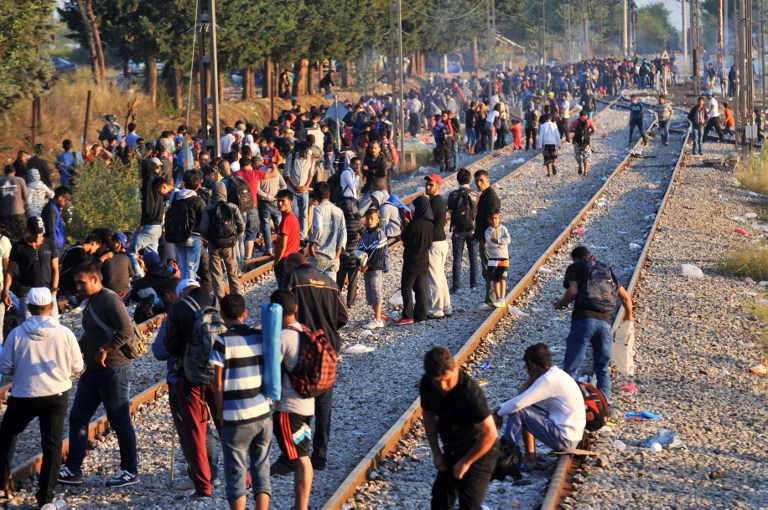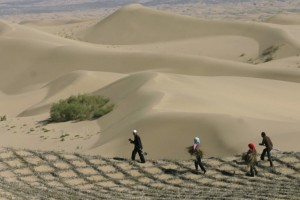
Migrants and refugees wait to cross the Greece-F.Y.R. Macedonia border near the village of Idomeni, in northern Greece on September 13, 2015. Three people, including a child, drowned when a boat carrying some 100 migrants capsized off Greece early on September 13, the Athens News Agency reported. It said the coastguard had rescued 68 people following the incident off the island of Farmakonisi in the Southern Aegean Sea. AFP PHOTO /STR
The Value of Land, published today by The Economics of Land Degradation Initiative, offers a shocking depiction of the state of our global environment. According to this new study, the percentage of land affected by serious drought has doubled from the 1970s to the early 2000s. One third of the world appears vulnerable to further land degradation. About half of our planet’s agricultural land is moderately or severely degraded.
There is no doubt that this situation will have major impacts on the livelihood of millions of people, especially the poorest of the poor. It might also reinforce current migration patterns. As many studies over the last decades have shown, large groups of people are likely to leave their degraded land in the future to migrate to other regions. Others will flee their homes due to civil strife, natural disasters, and persistent poverty, all of which might be exacerbated by environmental degradation, including global climate change. The Value of Land now adds a new prognosis to the ongoing debate on environmentally induced migration: according to the authors, about 50 million people may be forced to seek new homes and livelihoods within only 10 years. This group of migrants, if taken together, would constitute the world’s 28th largest country by population. Or to choose a more timely comparison: this group of new migrants would be equal to twice the population of Syria.
Europe has shown over this summer an utter lack of preparedness to deal with mass migrations from civil war regions, with most governments—with the exception of Germany, Sweden and few others—still hesitating about accepting significant numbers of asylum seekers. The United States, for example, has offered to accept merely 10,000 refugees so far. What will thus happen with the additional 50 million migrants that we can expect within the next 10 years, according to the The Value of Land?
Most likely, most migrants will stay within countries or confined regions. Most migration movements will also evolve over larger periods of time, and thus not be comparable to the more sudden migration movements that are typical for civil wars and violent conflicts. On the other hand, the current unprecedented influx of refugees into Europe shows that globalization, with its many facets, has also fundamentally changed global mobility patterns in a way that intensifies interdependencies among the world’s conflict zones and the rich countries in the West. Moreover, all migration movements related to land degradation and other types of environmental change have the potential of raising the conflict potential in their regions, adding to multiple social and economic hardships and additional migration pressures.
There is no doubt that the impacts of environmental degradation—including climate change—on local and transnational migration movements need to become an issue of highest political attention. Climate change and other types of global environmental change require global solutions that help protect people from further desertification, sea-level rise, water shortages, and other perturbations that are predicted by recent studies, including The Value of Land.
The international political system, however, is ill prepared. The United Nations was set up 70 years ago, and its founding document and basic institutional structures have remained basically unchanged since then. The word “environment” does not even once appear in the United Nations Charter. The 1951 U.N. Refugee Convention still reflects European experiences and problems of its period, responding to challenges of two World Wars and totalitarian regimes of that time. The Convention protects only people who have fled their countries because of persecution for reasons of race, religion, nationality, membership of a particular social group or political opinion. People who leave their homes because of land degradation, sea level rise or water shortages are not covered by the Convention, creating the increasingly artificial but politically and legally still crucial distinction between “refugees” persecuted in their home countries, on the one hand, and all other types of migrants, on the other. Syrians who flee terror attacks by Assad’s army are protected as “refugees;” Tuvaluan citizens who flee their islands because of rising sea levels and storm surges are merely “migrants.” This distinction seems in many ways outdated, for practical and for political reasons.
While it is seems unfeasible to formally amend the 1951 Refugee Convention to also cover people who flee environmental degradation, new legal standards and protection regimes for these people are urgently needed, especially with a view to the impacts of climate change. In 2008, I had proposed (with my colleague Dr. Ingrid Boas of Wageningen University) an international treaty on the recognition, protection and (voluntary) resettlement of climate refugees in the form of a protocol to the U.N. climate convention. While some details of our proposal have become outdated due to the directions that climate negotiations have taken since then, it is clear that the basic need for an effective global regime on the protection of environmentally induced migrants is more urgent today than ever.
source

More Stories
Navalny’s death used to hide western failures in Ukraine and their support for Israel’s genocide
Gifts from Gaza
Vulture capital circles over the corpse of Ukraine…